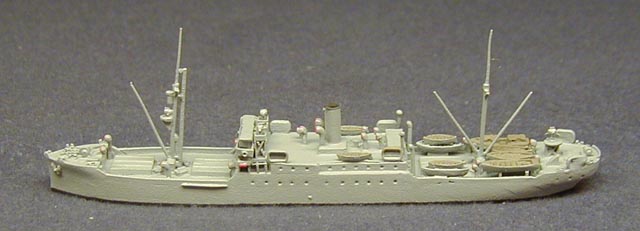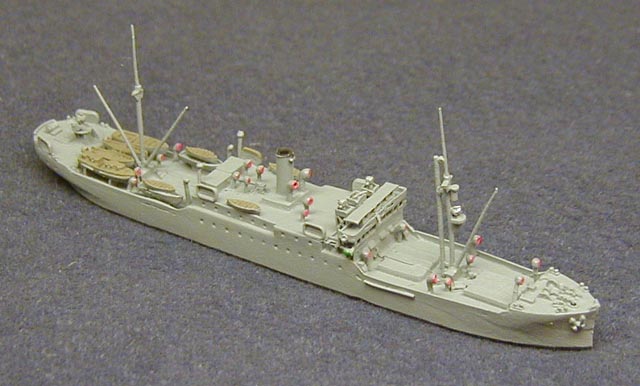U.S.S. Antares
AKS-3

1941
(Saratoga Model Shipyard SMY-16)
- Class: Antares - 1 ship of 1922
- Displacement: 5,050 tons
- Dimensions: 401 x 54 x 11.75 ft.
- Machinery: 2-shaft reciprocating (VTE), S.H.P. 2,500 = 11.5 knots
- Armament: 2-5"/51, 4-3"/50 A.A. guns authorized but not installed
- Complement: 197
- Builder: American International Shipbuilding Corp, Hog Island, PA
- Launched: 1919
- Acquired: 14 Nov 1921
- Commissioned: 23 Feb 1922
- Decommissioned: 2 Aug 1946
- Notes: Built under Shipping Board contract as Standard Type A Freighter Nedmac (Camden spelled backwards). Acquired by Navy as a miscellaneous auxiliary, AG-10, and renamed Antares. Designated flagship for the Train, Scouting Fleet; served as the fleet target repair and photographic ship in the Atlantic and Caribbean from 1922-1937. Moved to Pacific in 1938, operating out of San Pedro and then Pearl Harbor. Reclassified 30 Nov 1940 as a general stores issue ship, AKS-3. On 7 Dec 1941 she was entering Pearl Harbor at 0630 when she spotted a midget submarine and notified destroyer USS Ward, on patrol off the harbor entrance, which attacked and sank the intruder. However, this activity did not raise a general alarm before the arrival of the Japanese air assault. Antares received light damage in a strafing attack, against which she had no defense, her authorized armament never having been installed. She received repairs and had her guns installed by Apr 1942, and was dispatched to Pago Pago in May.She served at a variety of bases in the southwest Pacific, including Tongatabu, Noumea, Fiji, and Auckland, before getting a refit at San Francisco in May 1943. She made several more round trips from Jun 1943, eventually reaching Okinawa in May 1945. En route back to Pearl Harbor on 25 Jun 1945 she was attacked by two Japanese submarines, I-36 and I-165, and a kaiten mini-sub, but escaped without damage thanks to help from destroyer USS Sproston. After reaching Pearl Harbor safely, she sailed once more for Okinawa, arriving after the Japanese surrender was announced. She subsequently supported the occupation of Korea and China into the spring of 1946, finally returning to the U.S. in May for inactivation.Sold to Kaiser & Co. for scrapping in 1947.

 Previous
Previous
 Up
Up
 Next
Next



 Previous
Previous
 Up
Up
 Next
Next